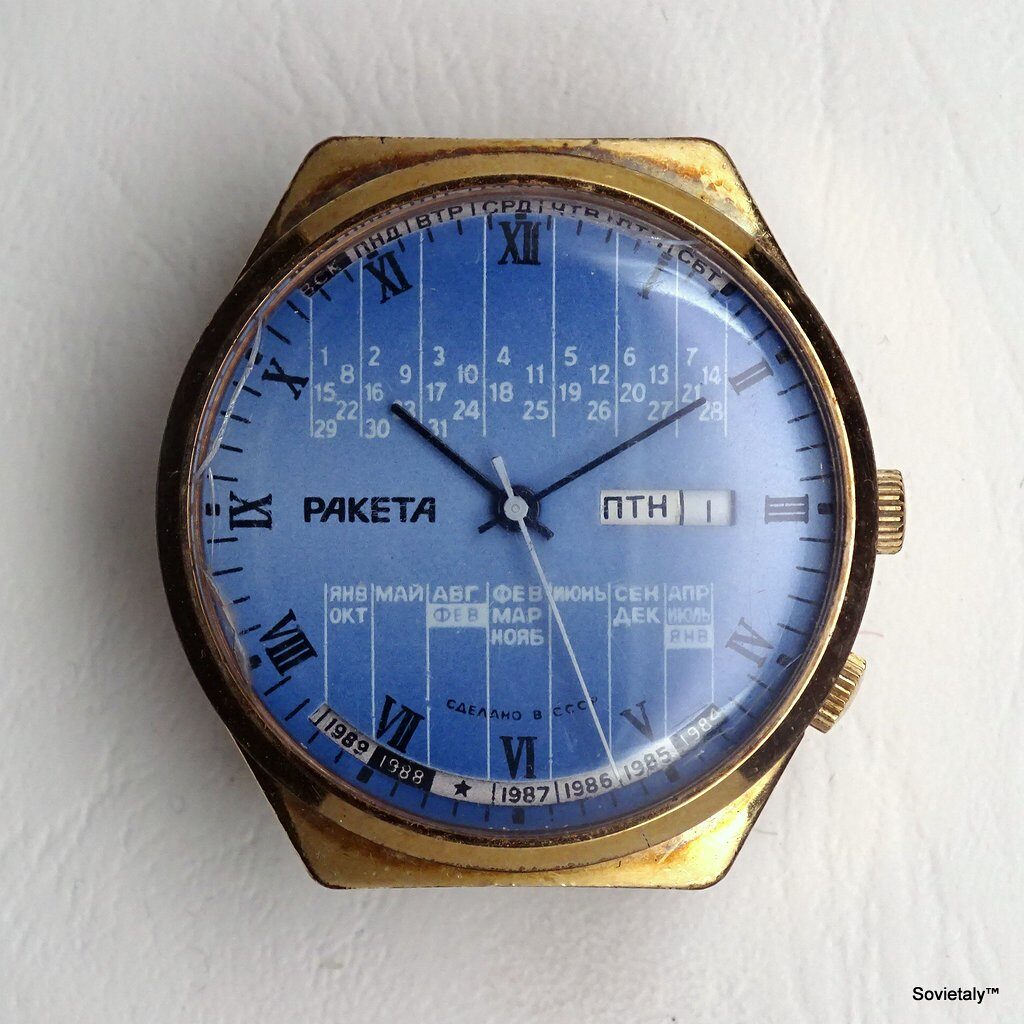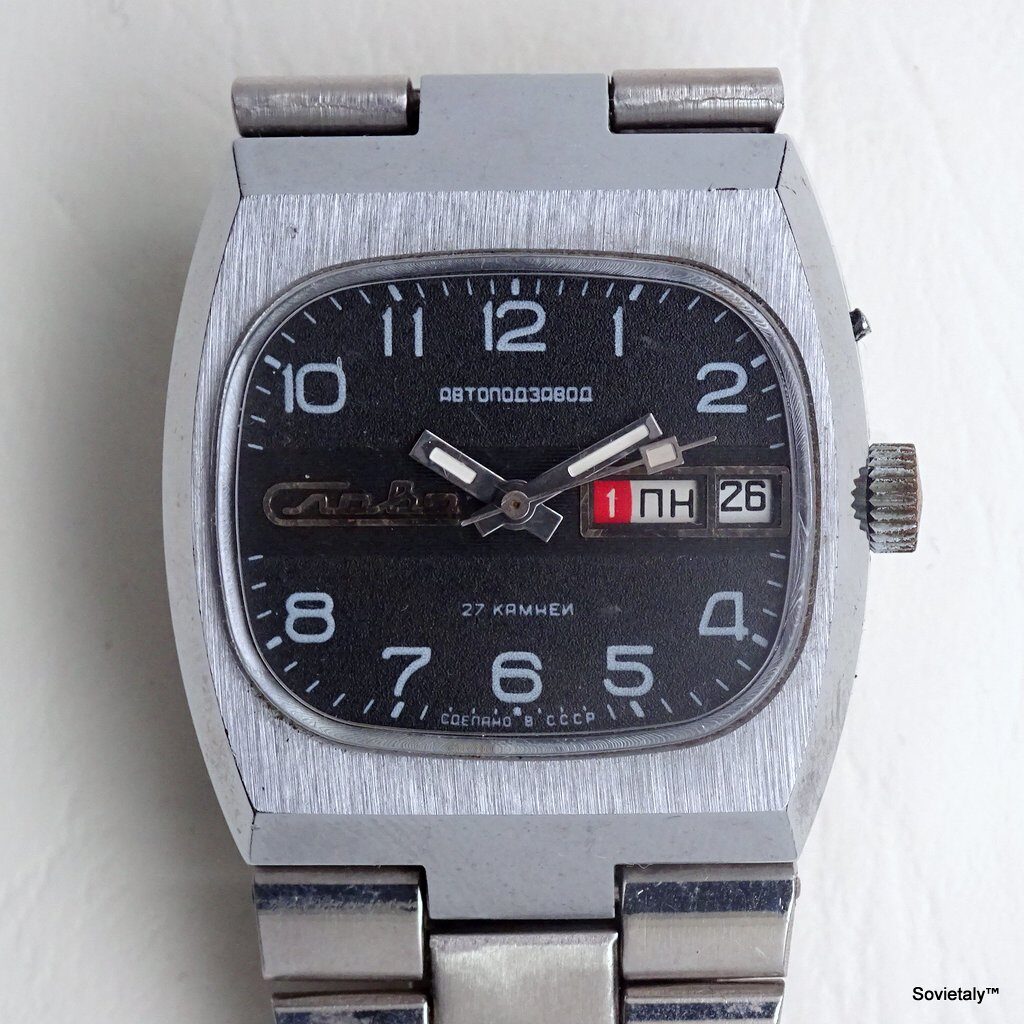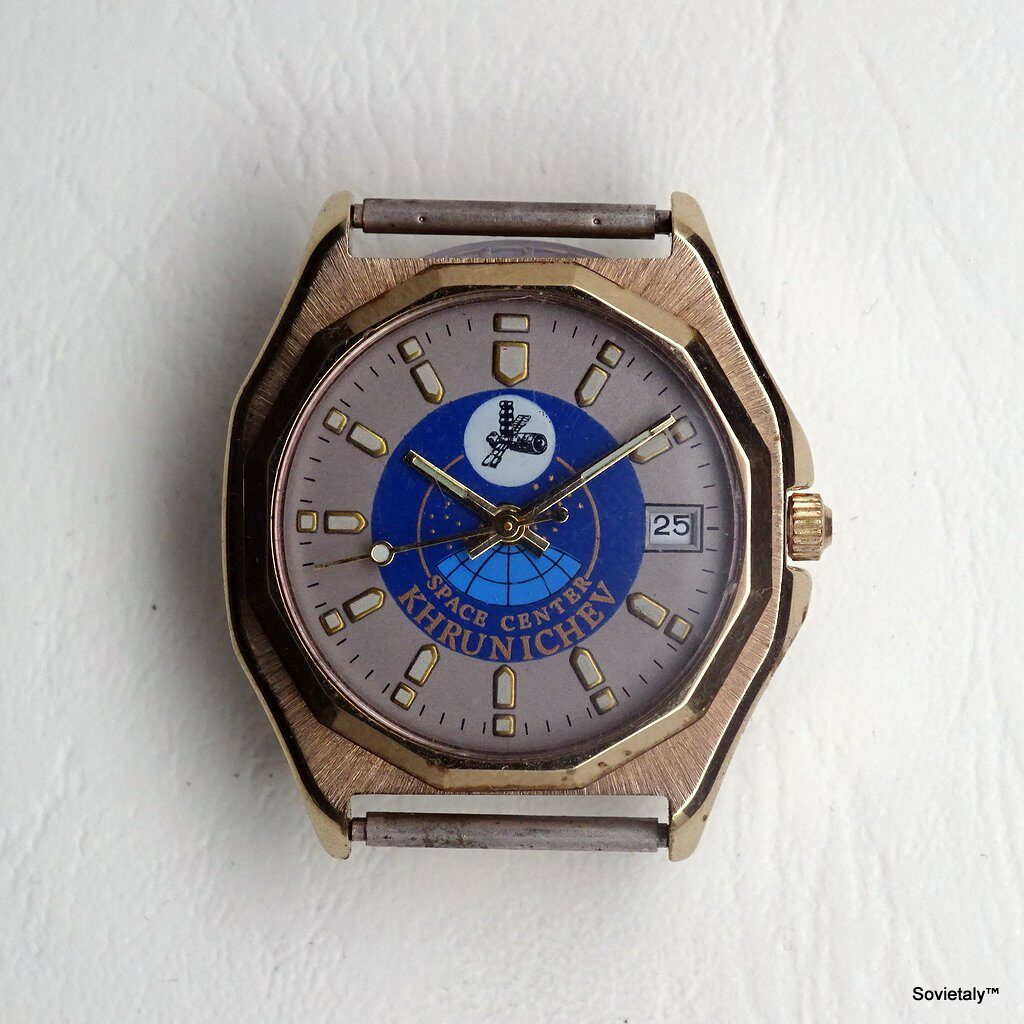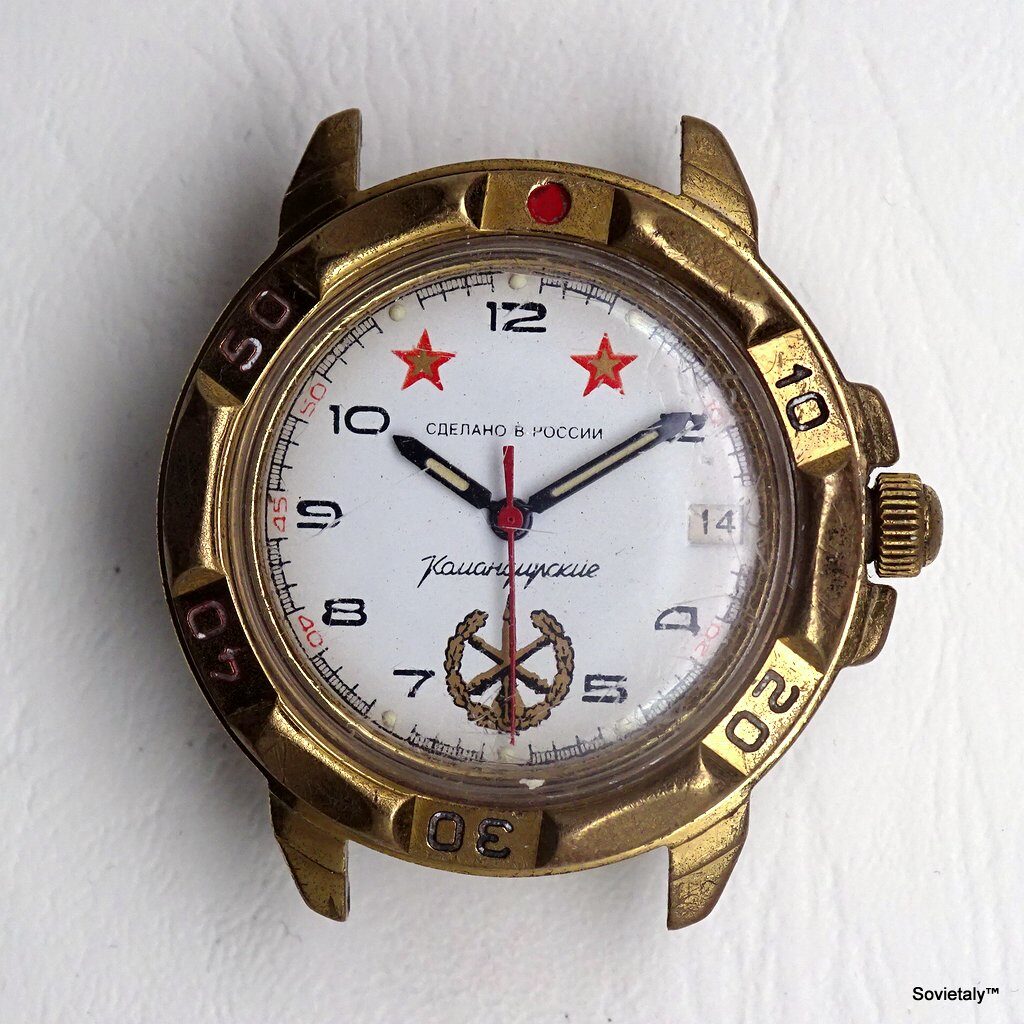Introduction to Ostwok
The Ostwok brand represents a fascinating chapter in horological history, blending the reliability of Soviet military watches with Swiss prestige and precision. Founded in 1993, Ostwok SA was based in Fehraltorf, Switzerland, and specialized in importing and distributing Russian Vostok watches under a brand that suggested Swiss origin. This article explores the company’s history, the details of its products, and the mysterious 1994 contest, providing a comprehensive overview of this intriguing phenomenon.
The Foundation of Ostwok SA
Ostwok SA was founded in 1993 in Fehraltorf, Switzerland, at Wingertstrasse 50, 8308 Illnau, Illnau-Effretikon, Switzerland. The company imported Vostok watches from the Soviet Union, known for their robustness and reliability, and distributed them in Europe under the Ostwok brand. With a share capital of 800,000 CHF distributed in 800 nominal shares of 1,000 CHF each, the company operated until 2002, when it was liquidated (kompany – global company intelligence) (kompany – global company intelligence).
Updated Values in Euros:
- 800,000 CHF in 1993: Assuming an average exchange rate of 1.50 CHF per euro and an annual inflation rate of 2%, this amount would be approximately 800,000 CHF x 0.66 = 528,000 EUR today.
- 1,000 CHF per share in 1993: Similarly, each share would be worth approximately 1,000 CHF x 0.66 = 660 EUR today.
Operational Address of Ostwok
From the attached image, it is seen that the operational address on the watch box was Ostwok SA, Postfach 200, Allmendstr. 30, CH-8320 Fehraltorf, Switzerland.

The Ostwok Brand
Ostwok is an anagram of Wostok, the German name for Vostok, chosen to facilitate correct pronunciation in German-speaking countries. The Ostwok logo, which replaced Vostok’s Cyrillic “B” with a “W”, was a distinctive feature and often included graphic symbols such as stars or military emblems. This branding aimed to create an image of Swiss watches, leveraging Switzerland’s reputation in watchmaking (WatchUSeek Watch Forums) (SOVIETALY™).

Ostwok Watches
The watches sold under the Ostwok brand were actually Vostok Komandirskie and Amphibia models, known for their robustness and durability. These watches, originally produced for the Red Army, featured mechanical movements and often had cases finished in titanium nitride. They were sold with a kit that included a cardboard box and a leaflet with instructions and warranty (TrademarkRegistrationOnline) (SOVIETALY™).



Registration in Canada
Ostwok SA registered several trademarks in Canada starting in 1994, including trademarks for horological and chronometric instruments and related accessories. However, the registration procedures were interrupted, and the trademarks were abandoned by 1998. This registration was part of a strategy to expand the brand’s international presence and protect it in global markets (TrademarkRegistrationOnline) (WatchUSeek Watch Forums).
The 1994 Contest
In 1994, Ostwok SA launched a contest to promote its watches. The contest offered significant prizes, including sums of money (SFr. 10,000 for the first prize and SFr. 5,000 for the second prize) and Ostwok watches. Participants had to correctly answer three questions regarding Ostwok SA’s headquarters, whether the watches required batteries, and the presence of a quality certificate. The deadline for submissions was 31 May 1994, and the winners were to be selected under notarial supervision. No further specific information about the contest’s outcome or winners has been found (SOVIETALY™) (SOVIETALY™) (WatchUSeek Watch Forums).
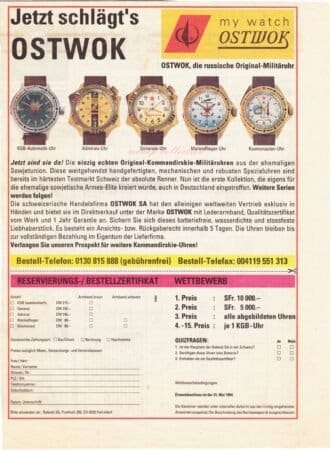
Translation of the Advertisement:
Jetzt schlägt’s OSTWOK
OSTWOK, die russische Original-Militäruhr
Jetzt sind sie da! Die einzig echten Original-Kommandirskie-Militäruhren aus der ehemaligen Sowjetunion. Diese weitgehendst handgefertigten, mechanischen und robusten Spezialuhren sind bereits im härtesten Testmarkt Schweiz der absolute Renner. Nun ist die erste Kollektion, die eigens für die ehemalige sowjetische Armee-Elite kreiert wurde, auch in Deutschland eingetroffen. Weitere Serien werden folgen!
Die schweizerische Handelsfirma OSTWOK SA hat den alleinigen weltweiten Vertrieb exklusiv in Händen und bietet sie im Direktverkauf unter der Marke OSTWOK mit Lederarmband, Qualitätszertifikat vom Werk und 1 Jahr Garantie an. Sichern Sie sich dieses batteriefreie, wasserdichte und stoßfeste Liebhaberstück. Es besteht ein Ansichts- bzw. Rückgaberecht innerhalb 5 Tagen. Die Uhren bleiben bis zur vollständigen Bezahlung im Eigentum der Lieferfirma.
Verlangen Sie unseren Prospekt für weitere Kommandirskie-Uhren!
Bestell-Telefon: 0130 815 888 (gebührenfrei)
Bestell-Telefax: 004119 551 313
RESERVIERUNGS-/ BESTELLZERTIFIKAT
| Anzahl | Armband braun | Armband schwarz | |||
|---|---|---|---|---|---|
| KGB (automatisch) | DM 215.- | [ ] | DM 220.- | [ ] | |
| General | DM 195.- | [ ] | DM 200.- | [ ] | |
| Admiral | DM 195.- | [ ] | DM 200.- | [ ] | |
| Marineflieger | DM 195.- | [ ] | DM 200.- | [ ] | |
| Kosmonaut | DM 89.- | [ ] | DM 94.- | [ ] |
Gewünschte Zahlungsart: [ ] Bar/Check
[ ] Rechnung
[ ] Nachnahme
Preise zuzüglich MwSt., Verpackungs- und Versandspesen
Frau/Herr:
Name/Vorname:
Strasse/Nr.:
PLZ/Ort:
Telefonnummer:
Geburtsdatum:
Datum, Unterschrift:
Bitte einsenden an: Ostwok SA, Postfach 200, CH-8320 Fehraltorf
Now it’s time for OSTWOK
OSTWOK, the original Russian military watch
Now they are here! The only genuine original Komandirskie military watches from the former Soviet Union. These predominantly handmade, mechanical, and robust special watches are already the absolute hit in the toughest Swiss test market. Now the first collection, specially created for the former Soviet army elite, has also arrived in Germany. More series will follow!
The Swiss trading company OSTWOK SA has exclusive worldwide distribution rights and offers them for direct sale under the OSTWOK brand with a leather strap, factory quality certificate, and a 1-year warranty. Secure these battery-free, waterproof, and shockproof collector’s items. There is a viewing and return right within 5 days. The watches remain the property of the supplier until full payment.
Request our brochure for more Komandirskie watches!
Order Telephone: 0130 815 888 (toll-free)
Order Fax: 004119 551 313
Reservation/Order Certificate
| Quantity | Brown Strap | Black Strap | |||
|---|---|---|---|---|---|
| KGB (automatic) | DM 215.- | [ ] | DM 220.- | [ ] | |
| General | DM 195.- | [ ] | DM 200.- | [ ] | |
| Admiral | DM 195.- | [ ] | DM 200.- | [ ] | |
| Naval Pilot | DM 195.- | [ ] | DM 200.- | [ ] | |
| Cosmonaut | DM 89.- | [ ] | DM 94.- | [ ] |
Preferred Payment Method: [ ] Cash/Check
[ ] Invoice
[ ] COD
Prices plus VAT, packaging, and shipping costs
Name/Surname:
Street/No.:
ZIP/City:
Telephone Number:
Date of Birth:
Date, Signature:
Please send to: Ostwok SA, Postfach 200, CH-8320 Fehraltorf
Contract with Switzerland
A period newspaper article describes the contract between a Swiss company, BN, and the Vostok watch factory. This contract involved the supply of 1.5 million “Commandant” watches and exclusive distribution in the West. Vostok’s administrative director, Vladimir Irnjiev, confirmed the details without revealing specific information about the Swiss partner or the contract amount (WatchUSeek Watch Forums).
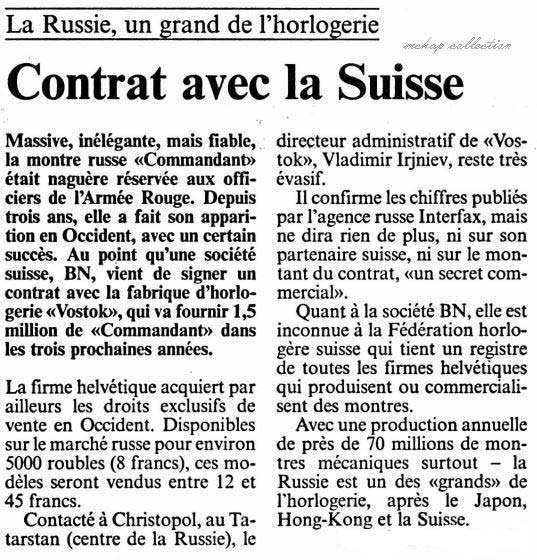
Text of the Article:
Massive, inelegant, but reliable, the Russian “Commandant” watch was once reserved for Red Army officers. For three years, it has made its appearance in the West, with some success. So much so that a Swiss company, BN, has just signed a contract with the “Vostok” watch factory, which will supply 1.5 million “Commandant” watches in the coming years.
The Swiss firm has also acquired exclusive sales rights in the West. Available on the Russian market for about 5000 rubles (about 45 francs), these massive watches are now distributed internationally.
Contacted in Chistopol, in the Tatarstan region (central Russia), the administrative director of “Vostok”, Vladimir Irnjiev, remains very evasive.
He confirms the data published by the Russian agency Interfax but says nothing more, neither about the Swiss partner nor about the amount of the contract, “a commercial secret”.
As for the BN company, it is unknown to the Swiss Watch Federation, which keeps a register of all Swiss companies that produce and market watches.
With an annual production of about 70 million watches, Russia is one of the “giants” of watchmaking, along with Japan, Hong Kong, and Switzerland.
Updated Values in Euros:
- 45 Swiss francs in 1994: With the same exchange rate and inflation, this amount would be about 45 CHF x 0,66 = 29,7 EUR today.
Additional Resources and Links
- Ostwok on Orologiko.it
- Ostwok on Watchuseek
- Information on the Ostwok Trademark
- Google Maps Link to the Address
Conclusion
With this information, we can better understand the history and uniqueness of Ostwok watches, an intriguing blend of Soviet reliability and European style. Ostwok represents a fascinating example of how watchmaking can unite different cultural and technical traditions, creating unique and sought-after products for collectors.



